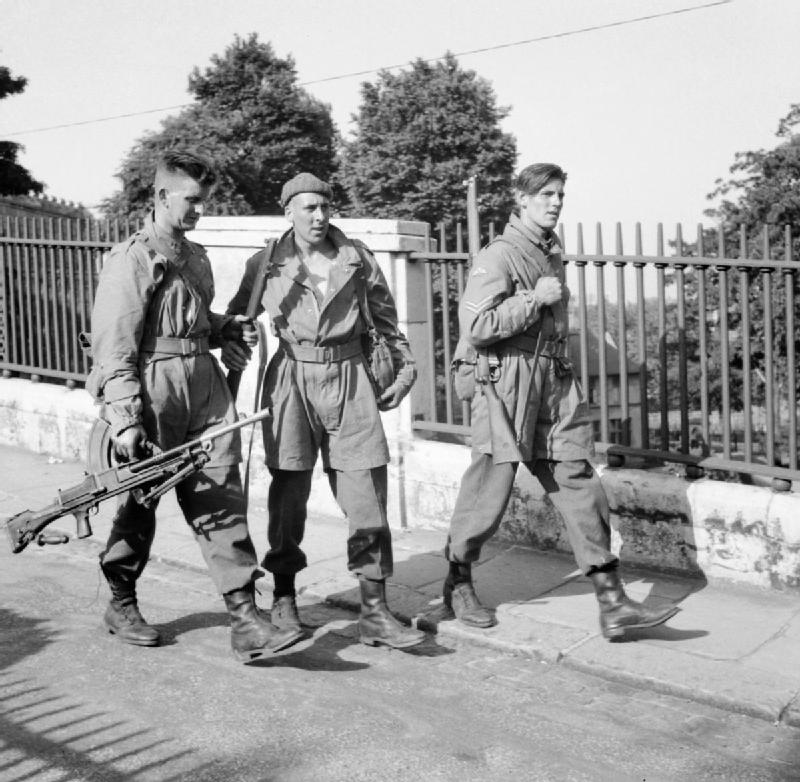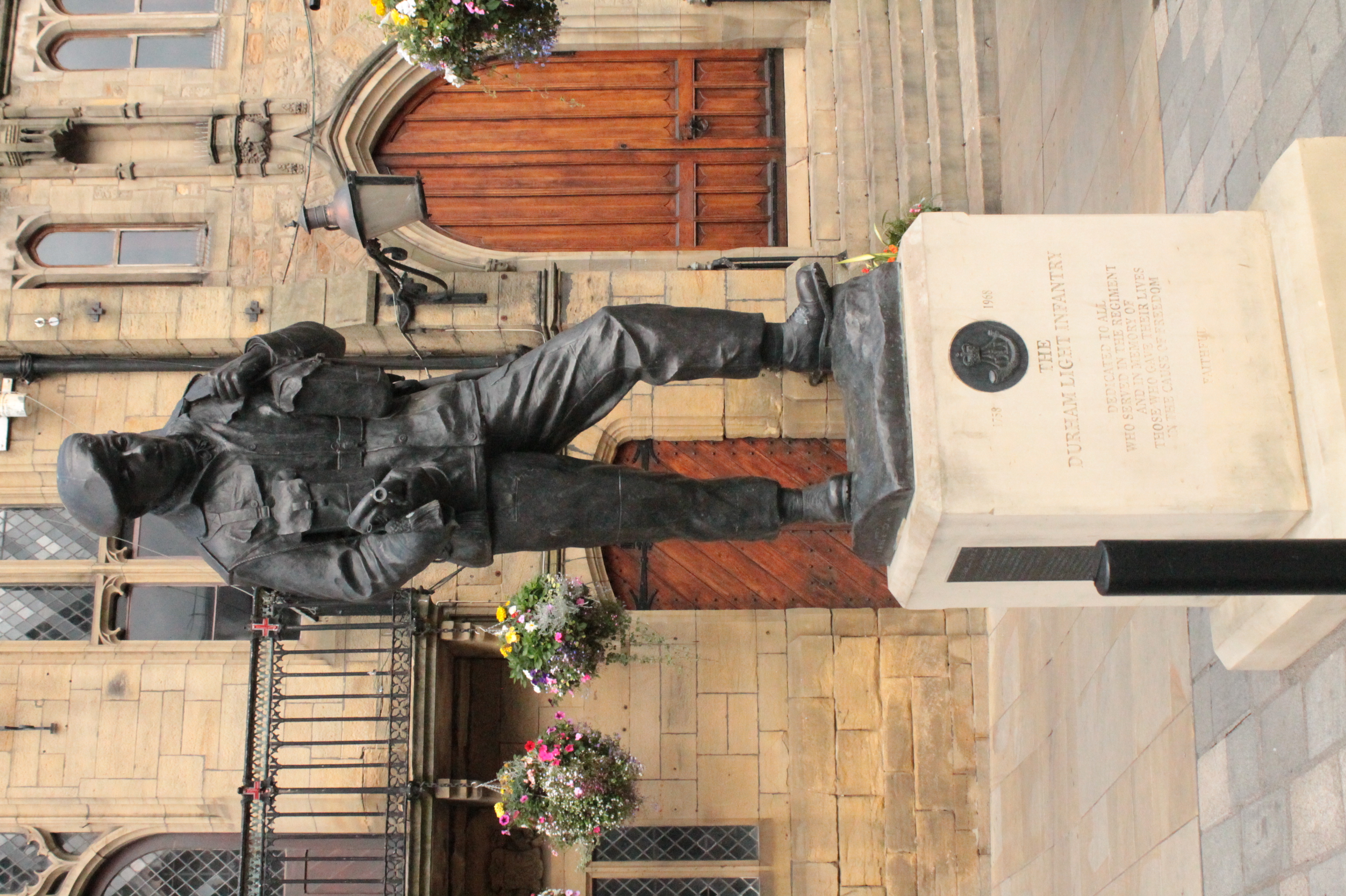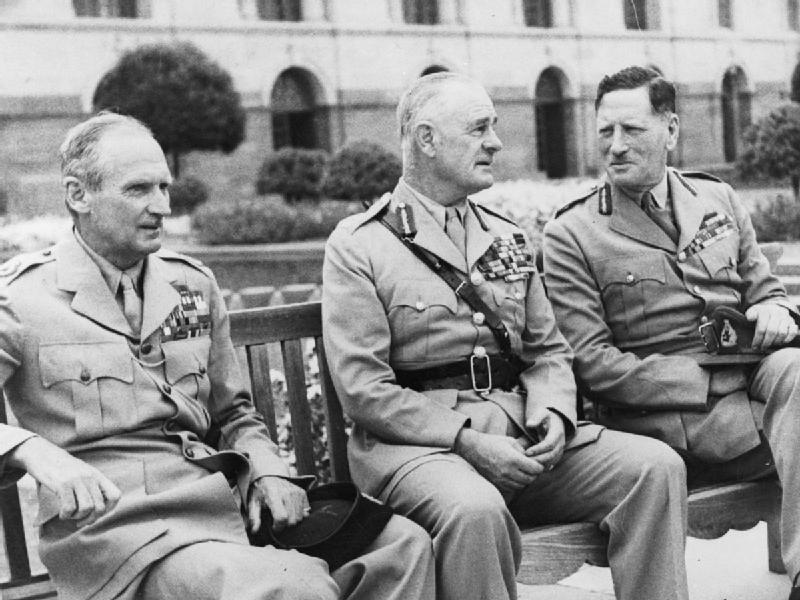|
17th Parachute Battalion (United Kingdom)
The 17th Parachute Battalion was an airborne infantry battalion of the Parachute Regiment, which was raised by the British Army during the Second World War. Regular army The battalion was raised in August 1945 and assigned to the reformed 1st Parachute Brigade. It was posted to Palestine with the 6th Airborne Division later that year. Post war reductions in the army resulted in the battalion being amalgamated with the 7th Parachute Battalion in 1946, keeping the number of the senior battalion. Territorial Army In 1947, a Territorial Army battalion was raised from the 9th Battalion Durham Light Infantry. The new battalion, the 17th (Durham Light Infantry) Parachute Battalion (TA), served in the 6th Parachute Brigade, 16th Airborne Division. Defence cuts in 1967 saw the battalion being amalgamated with the 12th/13th Parachute Battalion (which had been formed in 1956 by the merger of the 12th (Yorkshire) and the 13th (Lancashire) battalions) to become the 4th Battalion, Parach ... [...More Info...] [...Related Items...] OR: [Wikipedia] [Google] [Baidu] |
Parachute Regiment (United Kingdom)
The Parachute Regiment, colloquially known as the Paras, is an airborne infantry regiment of the British Army. The first battalion is part of the Special Forces Support Group under the operational command of the Director Special Forces. The other battalions are the parachute infantry component of the British Army's rapid response formation, 16 Air Assault Brigade. The Paras, along with the Guards, are the only line infantry regiment of the British Army that has not been amalgamated with another unit since the end of the Second World War. The Parachute Regiment was formed on 22 June 1940 during the Second World War and eventually raised 17 battalions. In Europe, these battalions formed part of the 1st Airborne Division, the 6th Airborne Division and the 2nd Independent Parachute Brigade Group. Another three battalions served with the British Indian Army in India and Burma. The regiment took part in six major parachute assault operations in North Africa, Italy, Greece, Fra ... [...More Info...] [...Related Items...] OR: [Wikipedia] [Google] [Baidu] |
6th Airborne Division (United Kingdom)
The 6th Airborne Division was an airborne infantry division of the British Army during the Second World War. Despite its name, the 6th was actually the second of two airborne divisions raised by the British Army during the war, the other being the 1st Airborne Division. The 6th Airborne Division was formed in the Second World War, in mid-1943, and was commanded by Major-General Richard N. Gale. The division consisted of the 3rd and 5th Parachute Brigades along with the 6th Airlanding Brigade and supporting units. The division's first mission was Operation Tonga on 6 June 1944, D-Day, part of the Normandy landings, where it was responsible for securing the left flank of the Allied invasion during Operation Overlord. The division remained in Normandy for three months before being withdrawn in September. The division was entrained day after day later that month, over nearly a week, preparing to join Operation Market Garden but was eventually stood down. While still recruiti ... [...More Info...] [...Related Items...] OR: [Wikipedia] [Google] [Baidu] |
4th Battalion, Parachute Regiment
The 4th Battalion, Parachute Regiment (4 PARA), is an Army Reserve unit of the British Army. Now recruiting across the United Kingdom originally the Battalion covered the North of England, with its headquarters located in Pudsey, West Yorkshire. Following the Options for Change review in 1993, 4 PARA amalgamated with the 15th (Scottish) Battalion of the Parachute Regiment (XV PARA), which was downsized and became 15 (Scottish) Company of 4 PARA. As part of further changes in 1999 (Strategic Defence Review), the Battalion also merged with the 10th (Volunteer) Battalion which then became 10 (London) Company. Under the Army 2020 plan, it formed a reserve air assault infantry battalion of 16 Air Assault Brigade. History The original 4th Parachute Battalion was formed in 1942 and saw service in; *Algeria ( as part of the British 1st Airborne Division during Operation Torch) *Tunisia (Supporting American forces) In 1943 Operation Avalanche (Invasion of Italy) was launched and the B ... [...More Info...] [...Related Items...] OR: [Wikipedia] [Google] [Baidu] |
13th (Lancashire) Parachute Battalion
The 13th (Lancashire) Parachute Battalion was an airborne infantry battalion of the Parachute Regiment, raised by the British Army during the Second World War. The battalion was formed in May 1943 by the conversion of the 2/4th Battalion, South Lancashire Regiment to parachute duties and was assigned to the 5th Parachute Brigade in the 6th Airborne Division. In June 1944, the battalion took part in Operation Tonga, the invasion of Normandy on D-Day, and the 6th Airborne Division advance to the River Seine, before being withdrawn back to England. Three months later they were sent to Belgium to help counter the surprise German Ardennes offensive, which became known as the Battle of the Bulge. Later, in March 1945, the battalion took part in the last airborne operation of the war: the River Rhine crossing in Germany. After the war in Europe ended, they were sent to India to conduct operations against the Japanese Empire, however, the war ended before they could begin. As a result, ... [...More Info...] [...Related Items...] OR: [Wikipedia] [Google] [Baidu] |
12th (Yorkshire) Parachute Battalion
The 12th (Yorkshire) Parachute Battalion was an airborne infantry battalion of the Parachute Regiment, raised by the British Army during the Second World War. The battalion was formed by the conversion of the 10th (East Riding Yeomanry) Battalion, Green Howards to parachute duties in May 1943. They were then assigned to the 5th Parachute Brigade, alongside the 7th and 13th Parachute battalions, which was part of the 6th Airborne Division. The battalion took part in Operation Tonga during the D-Day landings, capturing Ranville and held it against several German counter-attacks. It later fought in the Battle of Breville, and played a part in the 6th Airborne Division advance to the River Seine, after which it was returned to England in September 1944. The battalion was deployed to the River Meuse with the 5th Parachute Brigade during the German Ardennes offensive in December. Its final mission in Europe was Operation Varsity, the River Rhine crossing in March 1945. They then adv ... [...More Info...] [...Related Items...] OR: [Wikipedia] [Google] [Baidu] |
12th/13th Parachute Battalion
1 (one, unit, unity) is a number representing a single or the only entity. 1 is also a numerical digit and represents a single unit of counting or measurement. For example, a line segment of ''unit length'' is a line segment of length 1. In conventions of sign where zero is considered neither positive nor negative, 1 is the first and smallest positive integer. It is also sometimes considered the first of the infinite sequence of natural numbers, followed by 2, although by other definitions 1 is the second natural number, following 0. The fundamental mathematical property of 1 is to be a multiplicative identity, meaning that any number multiplied by 1 equals the same number. Most if not all properties of 1 can be deduced from this. In advanced mathematics, a multiplicative identity is often denoted 1, even if it is not a number. 1 is by convention not considered a prime number; this was not universally accepted until the mid-20th century. Additionally, 1 is ... [...More Info...] [...Related Items...] OR: [Wikipedia] [Google] [Baidu] |
16th Airborne Division
The 16th Airborne Division was an airborne infantry division of the British Territorial Army. It was first commanded by Major-General Roy Urquhart, and had its divisional headquarters in London. It was raised in 1947, to compensate for the loss of the 1st Airborne Division, which had been disbanded in 1945 and the 6th Airborne Division which was to be disbanded in 1948. The number "16" was used in recognition of the two wartime airborne divisions. The division had three parachute brigades, the 4th, 5th and the 6th, each with three Territorial battalions of the Parachute Regiment. The brigades were renumbered the 44th, 45th and 46th in 1950. Then in December 1955, the British Secretary of State for War in an announcement on the future of the Territorial Army, proposed cutting the Territorial Battalion, The Parachute Regiments by five. The reduction in strength led to the disbandment of the division in 1956, leaving the 44th Independent Parachute Group as the only British ... [...More Info...] [...Related Items...] OR: [Wikipedia] [Google] [Baidu] |
6th Parachute Brigade
6 (six) is the natural number following 5 and preceding 7. It is a composite number and the smallest perfect number. In mathematics Six is the smallest positive integer which is neither a square number nor a prime number; it is the second smallest composite number, behind 4; its proper divisors are , and . Since 6 equals the sum of its proper divisors, it is a perfect number; 6 is the smallest of the perfect numbers. It is also the smallest Granville number, or \mathcal-perfect number. As a perfect number: *6 is related to the Mersenne prime 3, since . (The next perfect number is 28 (number), 28.) *6 is the only even perfect number that is not the sum of successive odd cubes. *6 is the root of the 6-aliquot tree, and is itself the aliquot sum of only one other number; the square number, . Six is the only number that is both the sum and the product of three consecutive positive numbers. Unrelated to 6's being a perfect number, a Golomb ruler of length 6 is a "perfect ruler". Si ... [...More Info...] [...Related Items...] OR: [Wikipedia] [Google] [Baidu] |
Durham Light Infantry
The Durham Light Infantry (DLI) was a light infantry regiment of the British Army in existence from 1881 to 1968. It was formed in 1881 under the Childers Reforms by the amalgamation of the 68th (Durham) Regiment of Foot (Light Infantry) and the 106th Regiment of Foot (Bombay Light Infantry) along with the Militia and Volunteers of County Durham. The regiment served notably in the Second Boer War, World War I and World War II, the Korean War and the Indonesia–Malaysia confrontation. During times of peace it had duty in India, China, West Germany and Cyprus. In 1968, the regiment was amalgamated with the Somerset and Cornwall Light Infantry, the King's Own Yorkshire Light Infantry and the King's Shropshire Light Infantry to form The Light Infantry, which again amalgamated in 2007 with the Devonshire and Dorset Regiment, the Royal Gloucestershire, Berkshire and Wiltshire Regiment and the Royal Green Jackets to form a new large regiment, The Rifles, which continues the lineag ... [...More Info...] [...Related Items...] OR: [Wikipedia] [Google] [Baidu] |
Army Reserve (United Kingdom)
The Army Reserve is the active-duty volunteer reserve force of the British Army. It is separate from the Regular Reserve whose members are ex-Regular personnel who retain a statutory liability for service. The Army Reserve was known as the Territorial Force from 1908 to 1921, the Territorial Army (TA) from 1921 to 1967, the Territorial and Army Volunteer Reserve (TAVR) from 1967 to 1979, and again the Territorial Army (TA) from 1979 to 2014. The Army Reserve was created as the Territorial Force in 1908 by the Secretary of State for War, Richard Haldane, when the Territorial and Reserve Forces Act 1907 combined the previously civilian-administered Volunteer Force, with the mounted Yeomanry (at the same time the Militia was renamed the Special Reserve). Haldane planned a volunteer "Territorial Force", to provide a second line for the six divisions of the Expeditionary Force which he was establishing as the centerpiece of the Regular Army. The Territorial Force was to be com ... [...More Info...] [...Related Items...] OR: [Wikipedia] [Google] [Baidu] |
7th (Light Infantry) Parachute Battalion
The 7th (Light Infantry) Parachute Battalion was an airborne infantry battalion of the Parachute Regiment, formed by the British Army during the Second World War. The battalion was raised in November 1942 by the conversion of the 10th Battalion, Somerset Light Infantry to parachute duties. It was initially assigned to the 3rd Parachute Brigade, part of 1st Airborne Division, but moved to the 5th Parachute Brigade, alongside the 12th and 13th Parachute battalions, of the 6th Airborne Division soon afterwards. The battalion saw combat on D-Day in Operation Tonga on 6 June 1944, the Battle of the Bulge in December and the River Rhine crossing in March 1945. After the war ended in Europe, the battalion, with the 5th Parachute Brigade, was sent to the Far East to undertake operations against the Japanese Empire. However, the war ended just after the men had started jungle training. Moving by sea, the battalion took part in the reoccupation of Malaya and Singapore. Problems in Ja ... [...More Info...] [...Related Items...] OR: [Wikipedia] [Google] [Baidu] |
British Army During The Second World War
At the start of 1939, the British Army was, as it traditionally always had been, a small volunteer professional army. At the beginning of the World War II, Second World War on 1 September 1939, the British Army was small in comparison with those of its enemies, as it had been at the beginning of the World War I, First World War in 1914. It also quickly became evident that the initial structure and manpower of the British Army was woefully unprepared and ill-equipped for a war with multiple enemies on multiple fronts. During the early war years, mainly from 1940 to 1942, the British Army suffered defeat in almost every Theater (warfare), theatre of war in which it was deployed. But, from late 1942 onwards, starting with the Second Battle of El Alamein, the British Army's fortunes changed and it rarely suffered another defeat. While there are a number of reasons for this shift, not least the entrance of both the Soviet Union and the United States in 1941, as well as the Cryptanal ... [...More Info...] [...Related Items...] OR: [Wikipedia] [Google] [Baidu] |







